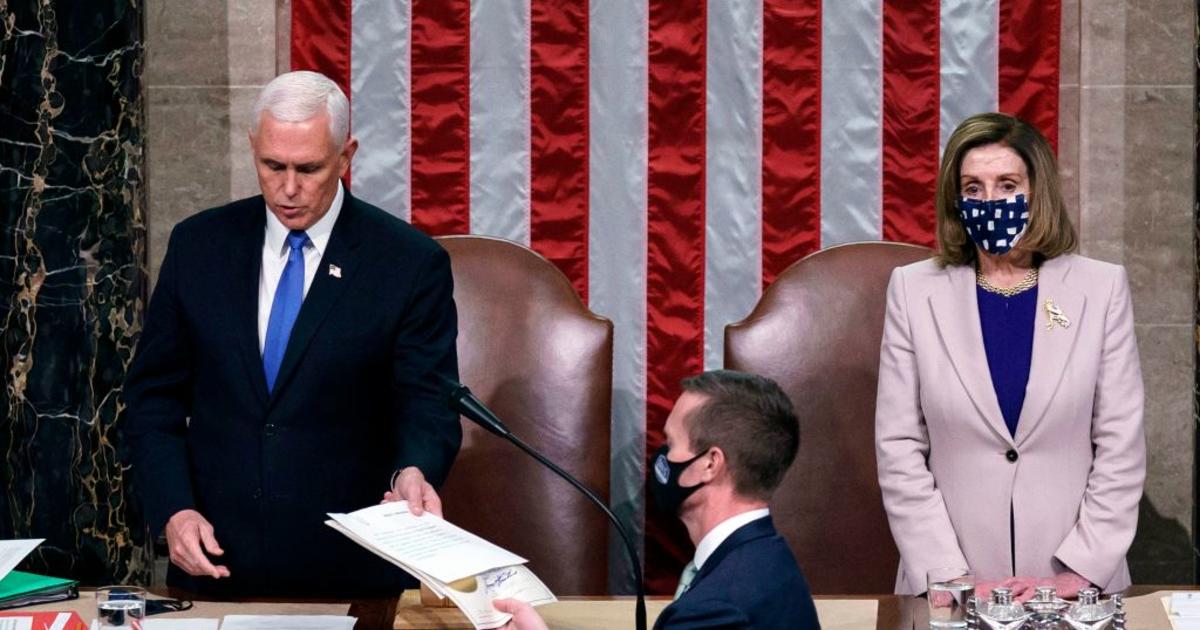
Washington — When Congress convenes on Monday to count Electoral College votes from each state and finalize President-elect Donald Trump’s victory in the November presidential election, the violent attack on the U.S. Capitol that disrupted the joint session four years ago will be looming over the proceedings.
But unlike on Jan. 6, 2021, when then-Vice President Mike Pence faced pressure to unilaterally toss out electoral votes from battleground states, Monday’s joint session will be governed by a revised set of procedures that clarify the vice president’s role to prevent attempts to overturn the results of an election.
“The 2020 election exposed how ambiguities in the Electoral Count Act could be exploited to sow chaos and disrupt the peaceful transfer of presidential power,” said Holly Idelson, a policy strategist at Protect Democracy, a nonpartisan, nonprofit organization. “The bipartisan Electoral Count Reform Act of 2022 will help ensure future transitions proceed smoothly and honor the will of the voters.”
What is the Electoral Count Reform Act of 2022?
Saul Loeb/Pool via AP
In December 2022, Congress approved the changes as part of a broader government spending package. The legislation updated the Electoral Count Act, an 1887 law that laid out the framework for the casting and counting of Electoral College votes after a presidential election.
Called the Electoral Count Reform Act, the revised measure clarified the process that begins in the wake of Election Day and culminates with Congress confirming the winner of the presidential election during a joint session on Jan. 6. The goal of the legislation was to address ambiguities in the 1887 law that Trump’s allies seized on in 2020 to challenge the results of the election.
Trump faced federal charges as a result of the alleged scheme to subvert the transfer of power in 2020 but they were dismissed in late November after he won a second term. Several of the president-elect’s allies who allegedly helped orchestrate or participated in the plans were charged by local prosecutors in Arizona and Georgia. Some have agreed to plead guilty while others have denied wrongdoing.
What’s different about Jan. 6 this time?
Who certifies the state’s appointment of electors
After states make their pick for the White House on Election Day, “certificates of ascertainment” are issued that name the electors selected by the winning candidate for president and vice president.
The Electoral Count Reform Act makes clear the certificates of ascertainment are issued by each state’s executive, defined as the governor unless otherwise specified, no later than six days before the date the Electoral College meets, which was Dec. 17.
It also states that those certificates issued by governors “shall be treated as conclusive in Congress” with respect to the electors appointed. Under the law, federal courts are also the final deciders of questions regarding the appointment of electors arising under the Constitution or federal law, and their determinations “shall be conclusive in Congress.”
Following the 2020 election, groups of Trump’s electors met in key battleground states on the same day the Electoral College convened to cast votes for president and vice president based on the election results. They signed fake certifications falsely claiming they were the legitimate electors, according to federal and congressional investigations. Some of them were mailed to the vice president and other government officials.
Federal prosecutors said that under the plan developed by Trump and his allies, submitting the fraudulent slates of electors would create a fake controversy on Jan. 6 and position Pence to replace legitimate electors with those backing Trump.
The legitimate electors’ signed certificates, though, were added to the certificates of ascertainment from state executives before they were sent.
The limited role for the vice president
The Electoral Count Reform Act clarifies the role of the vice president — who serves as the president of the Senate — when overseeing the counting of electoral votes. Under the law, the vice president’s role is limited to “performing solely ministerial duties.” It explicitly denies the vice president the power to “solely determine, accept, reject or otherwise adjudicate or resolve disputes over the proper certificate of ascertainment of appointment of electors, the validity of electors, or the votes of electors.”
The provisions regarding the vice president are a direct response to the 2020 election, when Trump and his allies pressured Pence to reject the legitimate electoral votes from seven battleground states and either send them to state legislatures for review or use the fake slates of electors that supported Trump.
Pence resisted the pressure, writing in a letter to lawmakers on the morning of Jan. 6, 2021, that the Constitution constrained him “from claiming unilateral authority to determine which electoral votes should be counted and which should not.” He said the vice president’s role as presiding officer during the joint session is “largely ceremonial,” an opinion the 2022 law formally adopted.
“I do not believe that the Founders of our country intended to invest the vice president with unilateral authority to decide which electoral votes should be counted during the joint session of Congress, and no vice president in American history has ever asserted such authority,” Pence wrote.
Vice President Kamala Harris, whom Trump defeated in November, will preside over the joint session Monday and reaffirm the president-elect’s win.
A higher threshold for objections
The law also changed the procedures for objections to a state’s electoral votes. Under the Electoral Count Reform Act, an objection must be made in writing and be signed by at least one-fifth of senators and one-fifth of House members. Previously, objections had to be signed by just one senator and House member.
There are only two grounds for objections under the law: when a state’s electors were not lawfully certified under a certificate of ascertainment, or when the vote of at least one elector has not been regularly given.
If an objection is made and meets these requirements, the House and Senate separately consider them. An objection is sustained by a majority vote of each chamber.



